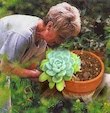A couple of months ago I visited a friend who had started a nursery just the other side of Magaliesburg (Gauteng, South Africa) and I was the lucky recipient of this gift - a Graptoveria "Fred Ives", already with a couple of pups, so I now have five plants.
Category: Succulent
Family:
Crassulaceae (Stonecrops)
Origin: Mexico (North America)
This succulent should be planted in fertile, free draining soil or a cacti well-drained mix. Water well during the warmer months, preferably from below, and sparingly in winter. Hardy hybrid tolerant of a wide range of conditions including some frost. It is reportedly a hybrid of Graptopetalum paraguayense crossed with a plant in the Echeveria gibbiflora complex.
Graptoveria can stay outdoors in summer. in mild climates it can grow in the garden where it takes lots of water without rotting. It is relatively slow growing and very slow to sucker (if at all). It prefers a bit of afternoon shade but does also well in bright light with high heat situations. It is adaptable to low light situations too.
It produces large clumps of rosettes to 8 inches tall by nearly 1 foot wide with broad bronze and pink succulent leaves atop short stems with 1’-2’ long branched inflorescences bearing red-orange centered pale yellow flowers in summer. The leaves are broad and stiff, overlapping each other, with concave upper surface, rubbery to the touch, waxy pearly-bronze to purplish yellow-orange to blue green (depending on time of year and growing conditons). Often shading from grey-blue at the centre out to orange-bronze-purple. The purple blush is fairly consistent throughout the seasons. Higher light and heat seem to increase the purple a bit, though.
Graptoveria pups sharing a basket with Lampranthus delosperma
This is a beautiful succulent for container planting, adding colour and texture to mixed collections. Excellent for windowsills or as a colour accent in rock or dish gardens. Ideal for adding dramatic foliage contrast to garden beds and borders and colour to the winter garden.
The crested form is usually propagated by division of the larger specimen. The standard (non crested) form is usually propagated by suckers or basal leaves, if If the plant is repotted some of the bottom leaves can be removed, in order to attempt leaf propagation, it is also a common practice to collect the leaves on the flower stem. However many such cuttings will dry out without producing a plantlet, but with perseverance it is likely to get a few new plants.
On the right in the plastic tub, some new kalanchoe rotundifolia propagations
::
